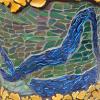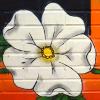"Water Music" at the GMOA and “And I Feel Fine” at ATHICA
Art Notes

Katsushika Hokusai's famous woodblock print "The Great Wave off Kanagawa" (ca 1830) is on display at the GMOA through Mar. 10.
Splish Splash: “Water Music,” on display at the Georgia Museum of Art through Mar. 10, showcases both visual and auditory expressions on the fluidity, universality and dynamic nature of Earth’s most prolific component: water.
“The Great Wave off Kanagawa,” the first in a series of color woodblock prints titled “Thirty-six Views of Mount Fuji” by Katsushika Hokusai, is one of the most iconic and recognized works of Japanese art in the world. As an “ukiyo-e,” a genre of leisure or everyday scenes literally translating to “pictures of the floating world,” the yin of the ominous, foam-clawed wave is balanced by the yang of steadfast fishermen.
Water-inspired visual artworks, such as the misty, dark “Rocky Shore” by American Luminist Alfred Thomas Bricher and “Far Blue,” a bare, abstract marsh scene by British landscape painter John Kings, are juxtaposed against conceptual musical selections in the exhibit’s listening station.
While George Frideric Handel’s “Water Music” was a composition originally performed for King George I on a barge on the River Thames, early avant-garde composer John Cage’s “Water Music” is an experimental work that instead incorporates the sound of water as a musical component, alongside a piano, radio, whistles and the shuffling of a deck of cards. “Water Passion After St. Matthew,” by Chinese contemporary classical composer Tan Dun, similarly substitutes traditional sounds by using amplified bowls of water as percussion. Yoko Ono’s “We’re All Water,” which lyrically explores the idea of water as an interconnecting life force between all humans, is the most pop-oriented track, despite Ono’s brief lapses into screeches and yelps.
Local pieces include “Sand Spits, Low Tide,” an oil painting by June Ball, a local seascape painter and MFA graduate from Lamar Dodd; a foam core construction of “St. Catherine’s, Near Sapelo Island, Georgia” by Claire Clements, associate professor emeritus of UGA’s College of Education; and “Layers of Reflection,” a cibachrome print by Judith McWillie, professor emeritus of drawing and painting at Lamar Dodd.
Optical Optimism: Named after R.E.M.’s 1987 hit “It’s the End of the World as We Know It (And I Feel Fine),” the group art show “And I Feel Fine,” on display at ATHICA through Mar. 16, attempts to present artists as optimists and cultural producers during a time of political, economic and natural calamity.
David Mazure’s “Defeated/Amputees (War),” part of his “New Mythologists: The Four Horsemen of the Apocalypse” series, is an installation of black-and-white, silk-screened tiles flocked with tire rubber that span the wall like wallpaper. The digitally manipulated, Baroque-like pattern was disturbingly abstracted from figure drawings of amputated limbs, lost due to corporate negligence, symbolizing the cruelty often hidden behind corporately driven production. Several tiles were randomly handed out at no charge during the exhibit’s opening reception, making an anti-materialist statement that reinforces the concept of capitalism existing as a culturally learned mythology that can be battled through the power of individual choice.
Two digital videos by Zachary Fabri, “Chanting Black Clouds” and “Forget Me Not, as My Tether Is Clipped,” use black balloons tied to the dreadlocks of a man to represent oppression; as the balloons are cut off, the subject is symbolically liberated.
“Shelter” by Suko Presseau presents a giant cluster of large photographs documenting starry skies, glowing horizons, barren trees and temporary tents from a 22-night stay in nature during winter. Inspired by Japanese philosopher Masnobua Fukouka’s assertion that farmers should live in simple shelters to understand the conditions of their land, Presseau demonstrates a heightened awareness and simple appreciation of the natural world. Presseau will lead a constellation walk at 3 Porch Farm in Comer on Saturday, Mar. 2 at 8 p.m.

Other works in the gallery include geometric paintings of brightly woven colors by Maya Hayuk, a cloud-like illustration of miniscule dashes by Caitlin Foster, a sound installation reconstructing a poem recalled from memory by Anthony Wislar and an installation of rice paper shapes resembling miniature caves by Liz Fuller.
"Morning After the Deluge," a segment featuring artist Paul Pfeiffer from PBS’s series "Art21," will be screened each day at 6 p.m., Thursday–Saturday, Feb. 21–23. A special performance by David Barnes (art director for of Montreal) and Nina Twin (Harouki Zombi) will be held on Sunday, Feb. 24 at 6 p.m. “The Apocalypse Didn’t Happen—Now What?,” a panel discussion moderated by Burnaway.org’s Susannah Darrow, will feature exhibiting artists Liz Fuller, Anthony Wislar and Suko Presseau as well as Emory scholar Meredith Kooi on Sunday, Mar. 3, at 2 p.m.
Art Rocks: The Art Rocks Athens Foundation, formally organized last spring for the purpose of documenting the history of Athens’ art and music scenes, is currently collecting information for a major retrospective exhibition, “Art Rocks Athens: 1975–1985.” Set to be on display from May through July of next year at the Lamar Dodd School of Art, the exhibit—along with an accompanying catalog of interviews and essays, a musical concert and satellite art shows throughout town—will explore the role and growth of visual arts beside the birth of the local music scene. Artists, art educators, collectors, bands and fans active during this decade are urged to share their recollections through an online questionnaire (available through May 14 at www.artrocksathens.com) which will be used to identify, locate and catalogue the works of art.
Arts Updates: If you’re jonesing for more news and information regarding local exhibits, performing arts, special lectures and other cool happenings in between issues, keep your pants on! And check out our newest supplementary arts blog, “Culture Briefs,” at Flagpole.com.
More by Jessica Smith
-

Art Around Town
A list of local art exhibits.
-

-

Art Around Town
A list of local art exhibits.









comments